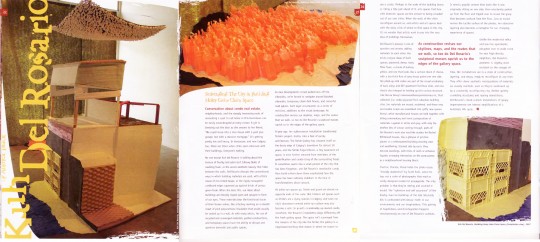Brunt Magazine
Issue #3
June 2007
Scavenging the City in Bubbling Holey Gobs Claim Space
By Anthea Black
bruntmag.com
Conversations about condo real estate, neighborhoods, and the steeply increasing costs for renovating a spot to call home in this boomtown can easily be eavesdropped at every corner. A girl is breezing out the door as she swoons to her friend, “We could move into a nice house with a yard plus garage, but with a massive mortgage.” It’s getting pretty hot and heavy. In Vancouver, and now Calgary too, there are times when cities seem obsessed with their buildings. Everyone’s talking.
No one except Kuh Del Rosario is talking about the texture of freshly laid astro-turf, billowy blobs of caulking foam, or the secret aesthetic beauty that hides between the walls. Del Rosario disrupts the conventional ways in which building materials are used, with a thick smear of mis-tinted taupe, or the ripply corrugated cardboard edges squeezed up against bricks of porous green foam. When she does this, our ideas about buildings are literally ripped open and splayed in front of our eyes. These materials bear the functional traces of their former selves, like a factory marking on a smooth sheet of pink polystyrene insulation that would usually be sealed up in a wall. As with many artists, her use of recycled and scavenged materials, partial constructions and temporary spaces have the ability to disrupt and question domestic and public spaces. As new developments crowd pedestrians off the sidewalks, we’re forced to navigate around blocked sidewalks, temporary chain-link fences, and colourful road pylons. Each layer accumulates as a series of revisions, additions to the visual landscape. As construction revises our skylines, maps, and the routes that we walk, so too do Del Rosario’s sculptural masses squish us to the edges of the gallery space.
A year ago, her subterranean installation transformed Stride’s project, Grotto, into feat of quirky architecture. The Stride Gallery has situated itself on the dusty edge of Calgary’s downtown for almost 10 years, and the Stride Project Room, a tiny basement art space, is even further removed from reminders of the gentrification and condo-izing of the surrounding ‘hood.’ It sometimes seems like a small pocket of the city that has been forgotten, and Del Rosario’s ramshackle candy floss build-a-thon down there emphasized how the space has been radically stubborn in the face of transformations above ground.
As artist-run spaces go, Stride and Grunt are almost on opposite ends of the scale. Old, historic art spaces such as Stride’s are dying species in Calgary, and soon our city’s downtown-centred artist-run culture may also become a relic. In Grunt’s considerably up-market condo storefront, Del Rosario’s installation plays differently off the fresh gallery space. The space isn’t scavenged from the margins of the city like Stride; the gallery is a negotiated territory that stands in where we expect to see a condo. Perhaps in the wake of the building boom, or riding a tide just ahead of it, arts spaces that fuse with domestic spaces are the answer to being crowded out of our own cities. When the walls of the cities reconfigure around us, and artists and art spaces deal with the daily crisis of where to find space in the city, it’s no wonder that artists want to pry into the very idea of buildings themselves.Del Rosario’s process is one of question and answer, adding materials to each other. Her bricks conjure ideas of built spaces: plastered, dense, hairy filter foam, a chunk of buttery yellow, and one that looks like a cartoon block of cheese, with a too-thick flow of grey house paint over on one side. Her piled-up milk crates are part of the visual vocabulary of back alleys and DIY apartment furniture alike, and now they’re also integral to holding us this curious structure. Like Donna Akrey’s Greenwoodhavenpointeterrace.inc, that collected (i.e. stole) plywood from suburban building sites, her materials are reused, reclaimed, and these very serviceable scraps are assembled into spiffy new spaces. Akrey’s artist-manufactured
house are held together with biting commentary and ironic juxtaposition of materials. Layered in white and grey, with only the briefest bits of colour coming through, parts of Del Rosario’s work also read like studies for Rachel Whiteread houses, like glimpse of pristine plaster or a whitewashed building showing wear and weathering. Stacked side by each, they become dwellings, with hints of roofs or entrance façades, arranging themselves on the same planes as a neighbourhood housing block.
Practice, Practise, Praxis hold the photo essay “mouldy modernism” by Scott Sarli, where he lays out a suite of photographs that read as coolly designed modernist propaganda. The only problem is that they’re rotting and covered in mould. The “optimism and self assurance” of the blocky, low-rise buildings of the late 50’s / early 60’s is contrasted with decay—both in our environments and imaginations. This paring of hopefulness and disintegration happens simultaneously on one of Del Rosarios’s surfaces.
It mimics grayish cement that looks like it was originally sitting on one side, then reluctantly peeled up from the floor and tipped over to reveal the goop that becomes unstuck from the floor. Just as mould revises the tactile surfaces of the photos, her obsessive layering also become a metaphor for our changing experience of spaces.Unlike the modernist relics and low-rise apartments ploughed over to make room for new high-density neighbours, Del Rosario’s aesthetic is slightly more resistant to the ravages of time. Her installations are in a state of construction, layering, and decay, ready to reconfigure at any time. They offer clever aesthetic manipulations of materials we usually overlook, even as they’re swallowed up by a constantly reconfiguring city. Amidst quietly crumbling structures and roaring demolitions, Del Rosario’s chock-a-block installations of goopy impermanence are intense amplifications of a building’s life cycle.
